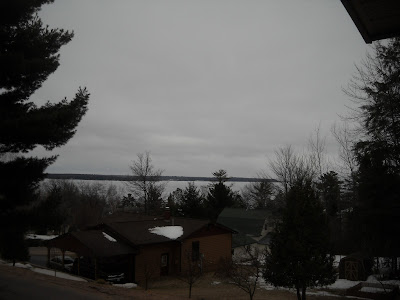 |
| OVERCAST, FOGGY AND WET |
 |
| SHRUB WILLOW TWIGS COLORING UP, READY FOR SPRING |
Saturday, 8:45 AM. 33 degrees, wind NW, light. There is a fine, wet snow falling, adding to the inch or so of slush already on the ground. The sky is overcast, and fog obscures Madeline Island. It looks as though this may settle in for a few days. Shrub willow branches are coloring up yellow and red, ready for spring.
The movie that Hollywood does not want you to see, and the book it does not want you to read, is “Atlas Shrugged,” by Ayn Rand. A lot of folks have heard of the 1957 novel, but I wager not as many have actually read it, as it is 1,000 pages long, a virtual Russian novel with many characters and a complex plot, akin to Brothers Karamazov or Crime and Punishment, and well it might be, since the author was an immigrant from Stalin’s Russia.
I don’t intend to write a book review here, but will give you the basic premise of the book, which is a futuristic view of what will happen to America if it continues on its present path. In that respect it is like “1984” or “Animal Farm.” What is truly chilling, and why it is so reviled by the socialists and unionists, is that America today is about two-thirds of the way towards the awful climax of the novel.
In essence it depicts what happens to a culture and a nation when society stifles the creativity and enterprise of the individual and replaces it with the ennui of the collective, where anyone who is more talented, smarter, or more ambitious than their peers is decried and oppressed. Where those who work hard and strive are forced to support society’s drones (of which there are as many perched on the highest rungs of society as on the lowest). Where political correctness and political cant suppress and punish freedom of expression. Where unions, big government and big business conspire to control the country and the world. Where all are equal, not in opportunity, but in misery. Where totalitarianism in the guise of charity enslaves all.
And what does happen when Atlas shrugs is that those who are carrying the world will eventually let it slip from their weary shoulders, and it will tumble into the abyss.
If the movie (actually movies…it will be a three part series) is true to the book, Michael Moore will try to prevent you from seeing it, and that in itself is a powerful incentive to buy a ticket. But please, read the book, and especially if you are a Wisconsinite, as a significant part of the story involves the Badger State.





























































